THE MARKETING MANAGEMENT
VerifiedAdded on 2022/08/27
|9
|2168
|55
AI Summary
Contribute Materials
Your contribution can guide someone’s learning journey. Share your
documents today.
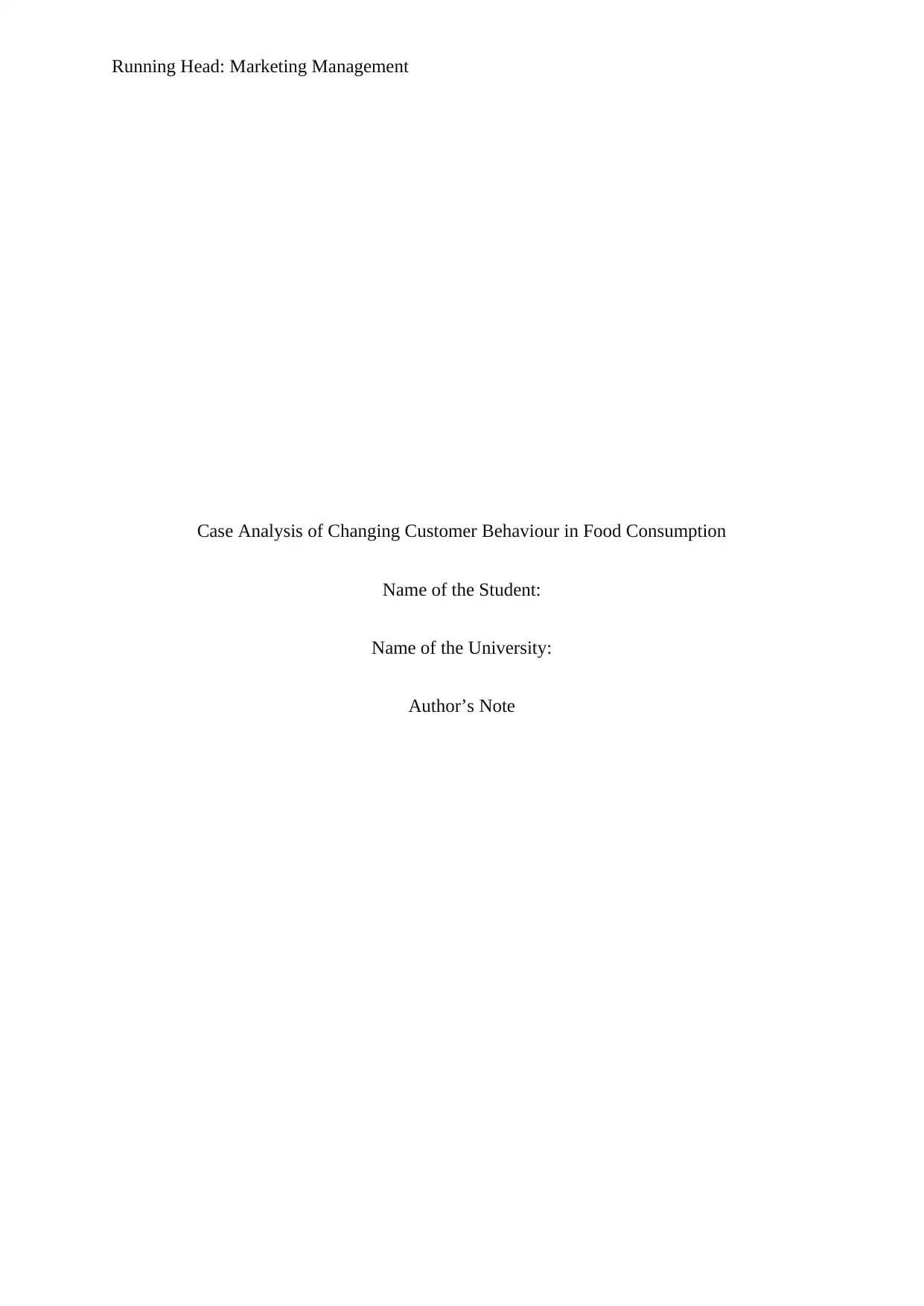
Running Head: Marketing Management
Case Analysis of Changing Customer Behaviour in Food Consumption
Name of the Student:
Name of the University:
Author’s Note
Case Analysis of Changing Customer Behaviour in Food Consumption
Name of the Student:
Name of the University:
Author’s Note
Secure Best Marks with AI Grader
Need help grading? Try our AI Grader for instant feedback on your assignments.
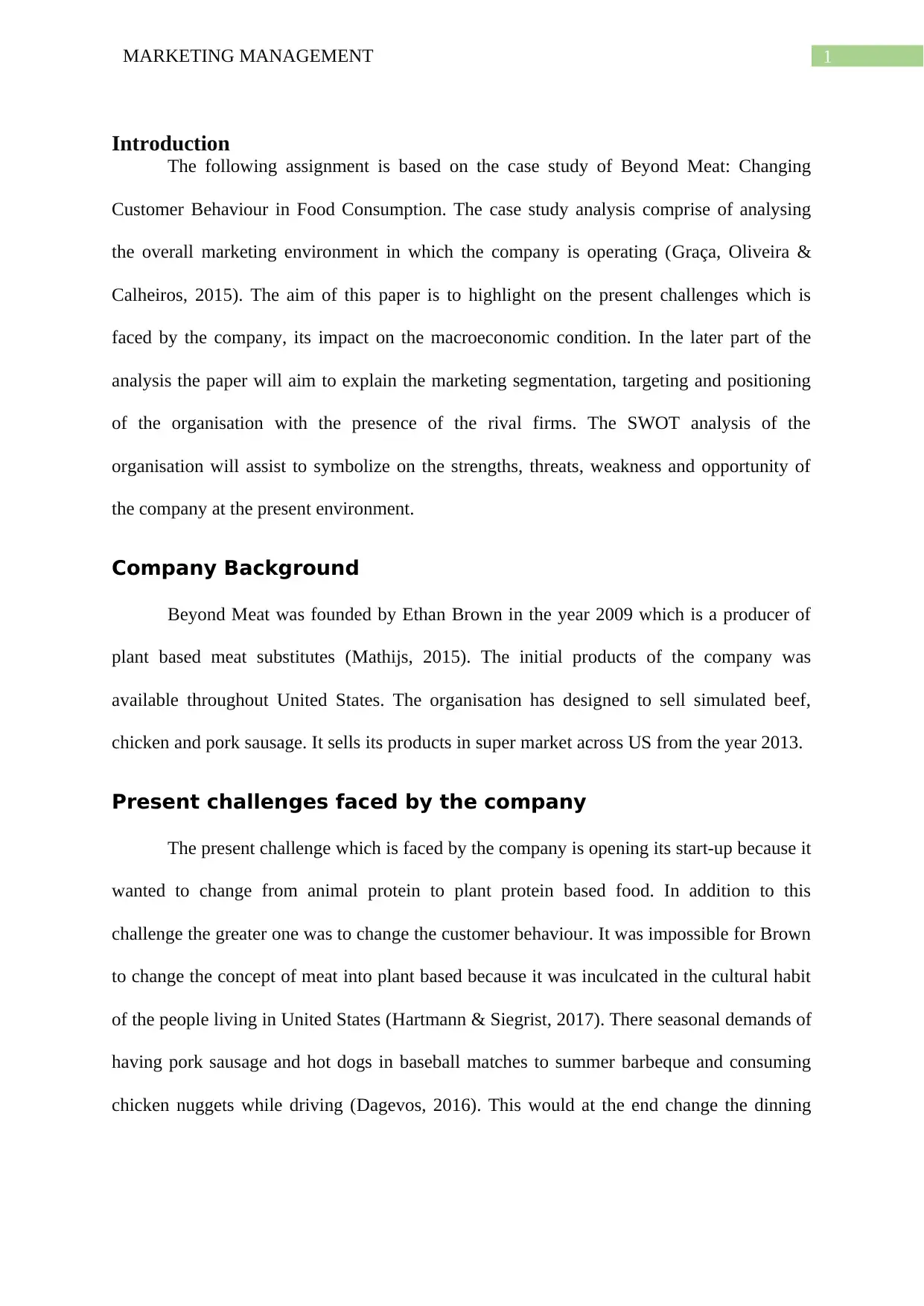
1MARKETING MANAGEMENT
Introduction
The following assignment is based on the case study of Beyond Meat: Changing
Customer Behaviour in Food Consumption. The case study analysis comprise of analysing
the overall marketing environment in which the company is operating (Graça, Oliveira &
Calheiros, 2015). The aim of this paper is to highlight on the present challenges which is
faced by the company, its impact on the macroeconomic condition. In the later part of the
analysis the paper will aim to explain the marketing segmentation, targeting and positioning
of the organisation with the presence of the rival firms. The SWOT analysis of the
organisation will assist to symbolize on the strengths, threats, weakness and opportunity of
the company at the present environment.
Company Background
Beyond Meat was founded by Ethan Brown in the year 2009 which is a producer of
plant based meat substitutes (Mathijs, 2015). The initial products of the company was
available throughout United States. The organisation has designed to sell simulated beef,
chicken and pork sausage. It sells its products in super market across US from the year 2013.
Present challenges faced by the company
The present challenge which is faced by the company is opening its start-up because it
wanted to change from animal protein to plant protein based food. In addition to this
challenge the greater one was to change the customer behaviour. It was impossible for Brown
to change the concept of meat into plant based because it was inculcated in the cultural habit
of the people living in United States (Hartmann & Siegrist, 2017). There seasonal demands of
having pork sausage and hot dogs in baseball matches to summer barbeque and consuming
chicken nuggets while driving (Dagevos, 2016). This would at the end change the dinning
Introduction
The following assignment is based on the case study of Beyond Meat: Changing
Customer Behaviour in Food Consumption. The case study analysis comprise of analysing
the overall marketing environment in which the company is operating (Graça, Oliveira &
Calheiros, 2015). The aim of this paper is to highlight on the present challenges which is
faced by the company, its impact on the macroeconomic condition. In the later part of the
analysis the paper will aim to explain the marketing segmentation, targeting and positioning
of the organisation with the presence of the rival firms. The SWOT analysis of the
organisation will assist to symbolize on the strengths, threats, weakness and opportunity of
the company at the present environment.
Company Background
Beyond Meat was founded by Ethan Brown in the year 2009 which is a producer of
plant based meat substitutes (Mathijs, 2015). The initial products of the company was
available throughout United States. The organisation has designed to sell simulated beef,
chicken and pork sausage. It sells its products in super market across US from the year 2013.
Present challenges faced by the company
The present challenge which is faced by the company is opening its start-up because it
wanted to change from animal protein to plant protein based food. In addition to this
challenge the greater one was to change the customer behaviour. It was impossible for Brown
to change the concept of meat into plant based because it was inculcated in the cultural habit
of the people living in United States (Hartmann & Siegrist, 2017). There seasonal demands of
having pork sausage and hot dogs in baseball matches to summer barbeque and consuming
chicken nuggets while driving (Dagevos, 2016). This would at the end change the dinning
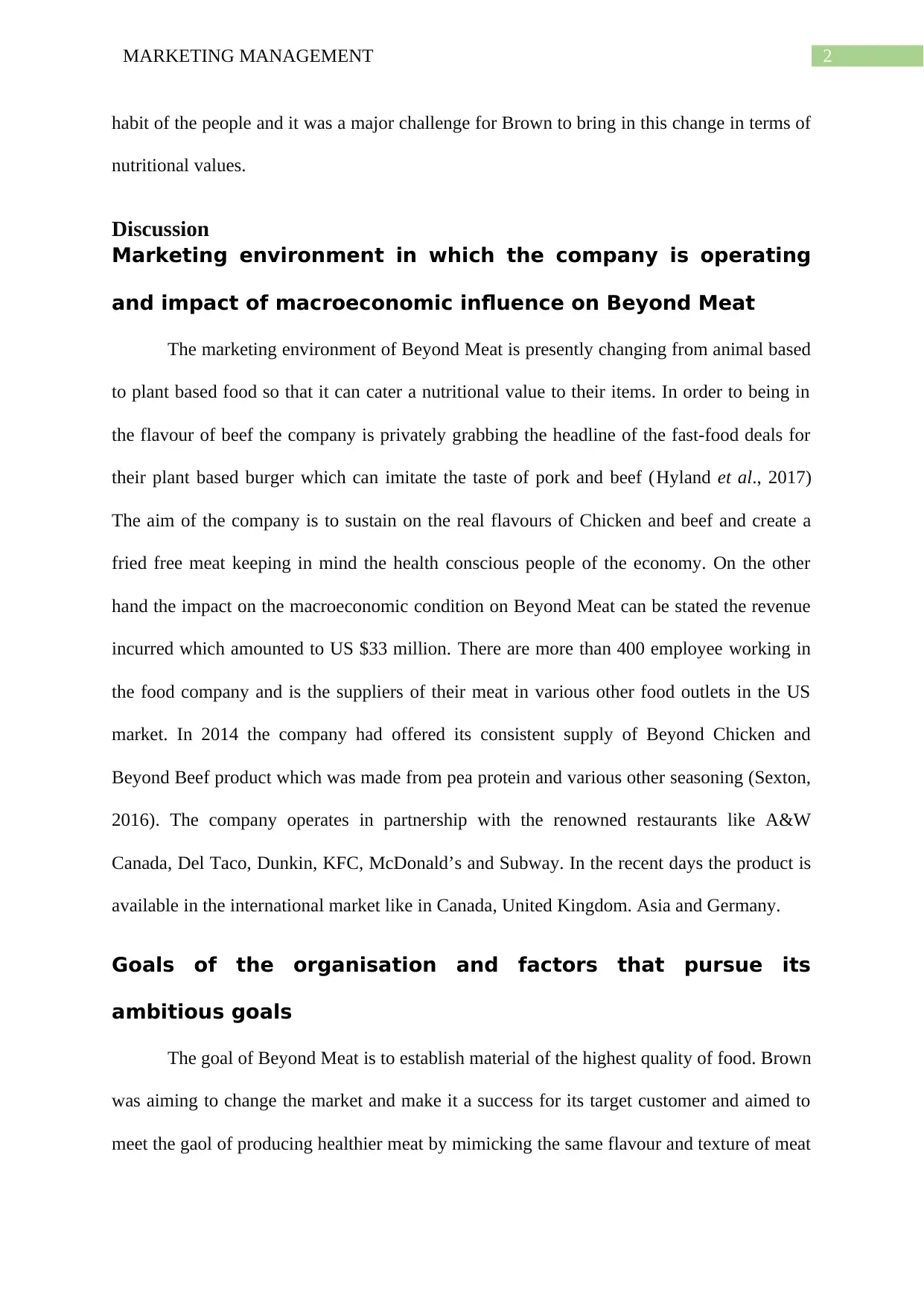
2MARKETING MANAGEMENT
habit of the people and it was a major challenge for Brown to bring in this change in terms of
nutritional values.
Discussion
Marketing environment in which the company is operating
and impact of macroeconomic influence on Beyond Meat
The marketing environment of Beyond Meat is presently changing from animal based
to plant based food so that it can cater a nutritional value to their items. In order to being in
the flavour of beef the company is privately grabbing the headline of the fast-food deals for
their plant based burger which can imitate the taste of pork and beef (Hyland et al., 2017)
The aim of the company is to sustain on the real flavours of Chicken and beef and create a
fried free meat keeping in mind the health conscious people of the economy. On the other
hand the impact on the macroeconomic condition on Beyond Meat can be stated the revenue
incurred which amounted to US $33 million. There are more than 400 employee working in
the food company and is the suppliers of their meat in various other food outlets in the US
market. In 2014 the company had offered its consistent supply of Beyond Chicken and
Beyond Beef product which was made from pea protein and various other seasoning (Sexton,
2016). The company operates in partnership with the renowned restaurants like A&W
Canada, Del Taco, Dunkin, KFC, McDonald’s and Subway. In the recent days the product is
available in the international market like in Canada, United Kingdom. Asia and Germany.
Goals of the organisation and factors that pursue its
ambitious goals
The goal of Beyond Meat is to establish material of the highest quality of food. Brown
was aiming to change the market and make it a success for its target customer and aimed to
meet the gaol of producing healthier meat by mimicking the same flavour and texture of meat
habit of the people and it was a major challenge for Brown to bring in this change in terms of
nutritional values.
Discussion
Marketing environment in which the company is operating
and impact of macroeconomic influence on Beyond Meat
The marketing environment of Beyond Meat is presently changing from animal based
to plant based food so that it can cater a nutritional value to their items. In order to being in
the flavour of beef the company is privately grabbing the headline of the fast-food deals for
their plant based burger which can imitate the taste of pork and beef (Hyland et al., 2017)
The aim of the company is to sustain on the real flavours of Chicken and beef and create a
fried free meat keeping in mind the health conscious people of the economy. On the other
hand the impact on the macroeconomic condition on Beyond Meat can be stated the revenue
incurred which amounted to US $33 million. There are more than 400 employee working in
the food company and is the suppliers of their meat in various other food outlets in the US
market. In 2014 the company had offered its consistent supply of Beyond Chicken and
Beyond Beef product which was made from pea protein and various other seasoning (Sexton,
2016). The company operates in partnership with the renowned restaurants like A&W
Canada, Del Taco, Dunkin, KFC, McDonald’s and Subway. In the recent days the product is
available in the international market like in Canada, United Kingdom. Asia and Germany.
Goals of the organisation and factors that pursue its
ambitious goals
The goal of Beyond Meat is to establish material of the highest quality of food. Brown
was aiming to change the market and make it a success for its target customer and aimed to
meet the gaol of producing healthier meat by mimicking the same flavour and texture of meat
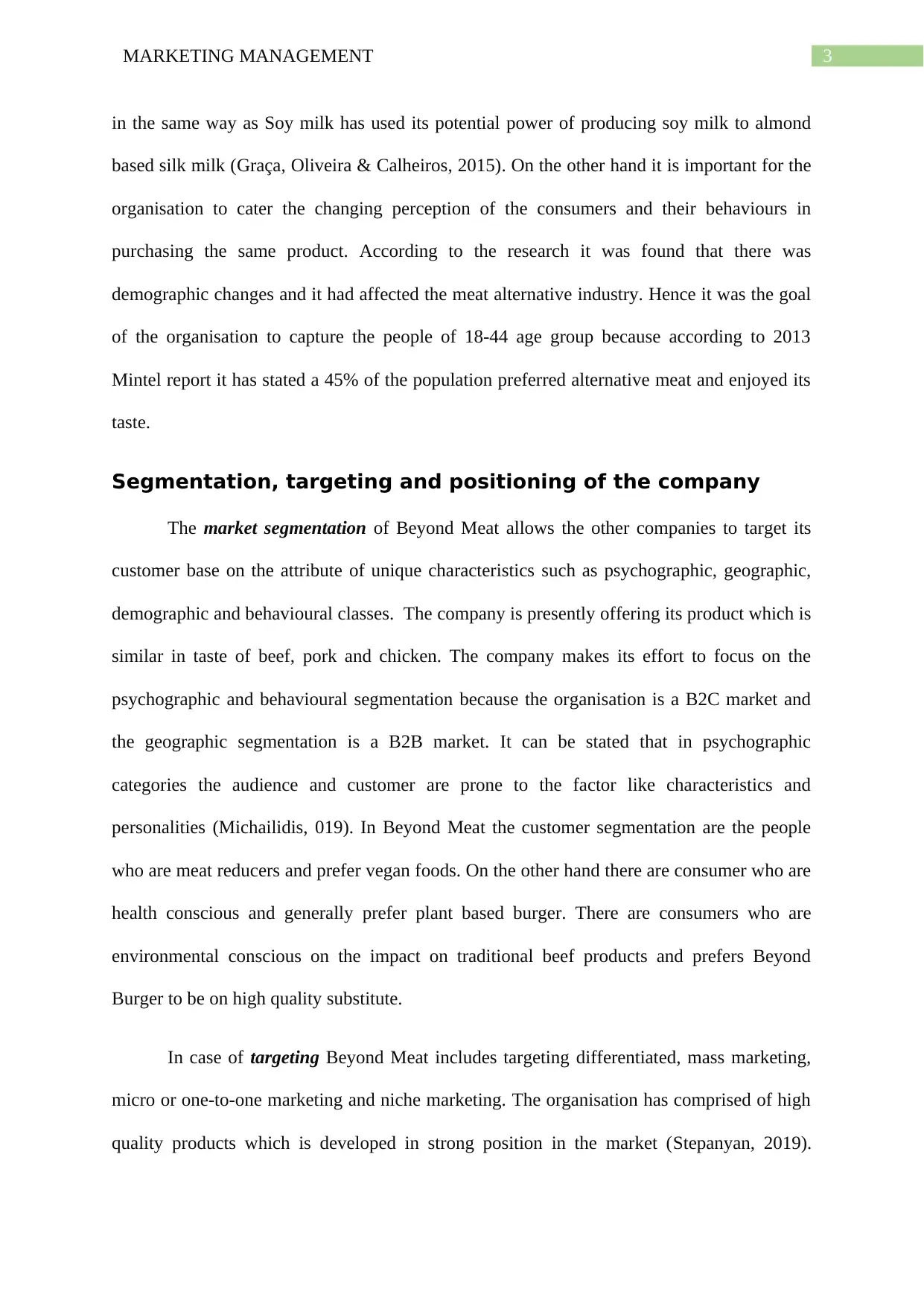
3MARKETING MANAGEMENT
in the same way as Soy milk has used its potential power of producing soy milk to almond
based silk milk (Graça, Oliveira & Calheiros, 2015). On the other hand it is important for the
organisation to cater the changing perception of the consumers and their behaviours in
purchasing the same product. According to the research it was found that there was
demographic changes and it had affected the meat alternative industry. Hence it was the goal
of the organisation to capture the people of 18-44 age group because according to 2013
Mintel report it has stated a 45% of the population preferred alternative meat and enjoyed its
taste.
Segmentation, targeting and positioning of the company
The market segmentation of Beyond Meat allows the other companies to target its
customer base on the attribute of unique characteristics such as psychographic, geographic,
demographic and behavioural classes. The company is presently offering its product which is
similar in taste of beef, pork and chicken. The company makes its effort to focus on the
psychographic and behavioural segmentation because the organisation is a B2C market and
the geographic segmentation is a B2B market. It can be stated that in psychographic
categories the audience and customer are prone to the factor like characteristics and
personalities (Michailidis, 019). In Beyond Meat the customer segmentation are the people
who are meat reducers and prefer vegan foods. On the other hand there are consumer who are
health conscious and generally prefer plant based burger. There are consumers who are
environmental conscious on the impact on traditional beef products and prefers Beyond
Burger to be on high quality substitute.
In case of targeting Beyond Meat includes targeting differentiated, mass marketing,
micro or one-to-one marketing and niche marketing. The organisation has comprised of high
quality products which is developed in strong position in the market (Stepanyan, 2019).
in the same way as Soy milk has used its potential power of producing soy milk to almond
based silk milk (Graça, Oliveira & Calheiros, 2015). On the other hand it is important for the
organisation to cater the changing perception of the consumers and their behaviours in
purchasing the same product. According to the research it was found that there was
demographic changes and it had affected the meat alternative industry. Hence it was the goal
of the organisation to capture the people of 18-44 age group because according to 2013
Mintel report it has stated a 45% of the population preferred alternative meat and enjoyed its
taste.
Segmentation, targeting and positioning of the company
The market segmentation of Beyond Meat allows the other companies to target its
customer base on the attribute of unique characteristics such as psychographic, geographic,
demographic and behavioural classes. The company is presently offering its product which is
similar in taste of beef, pork and chicken. The company makes its effort to focus on the
psychographic and behavioural segmentation because the organisation is a B2C market and
the geographic segmentation is a B2B market. It can be stated that in psychographic
categories the audience and customer are prone to the factor like characteristics and
personalities (Michailidis, 019). In Beyond Meat the customer segmentation are the people
who are meat reducers and prefer vegan foods. On the other hand there are consumer who are
health conscious and generally prefer plant based burger. There are consumers who are
environmental conscious on the impact on traditional beef products and prefers Beyond
Burger to be on high quality substitute.
In case of targeting Beyond Meat includes targeting differentiated, mass marketing,
micro or one-to-one marketing and niche marketing. The organisation has comprised of high
quality products which is developed in strong position in the market (Stepanyan, 2019).
Secure Best Marks with AI Grader
Need help grading? Try our AI Grader for instant feedback on your assignments.
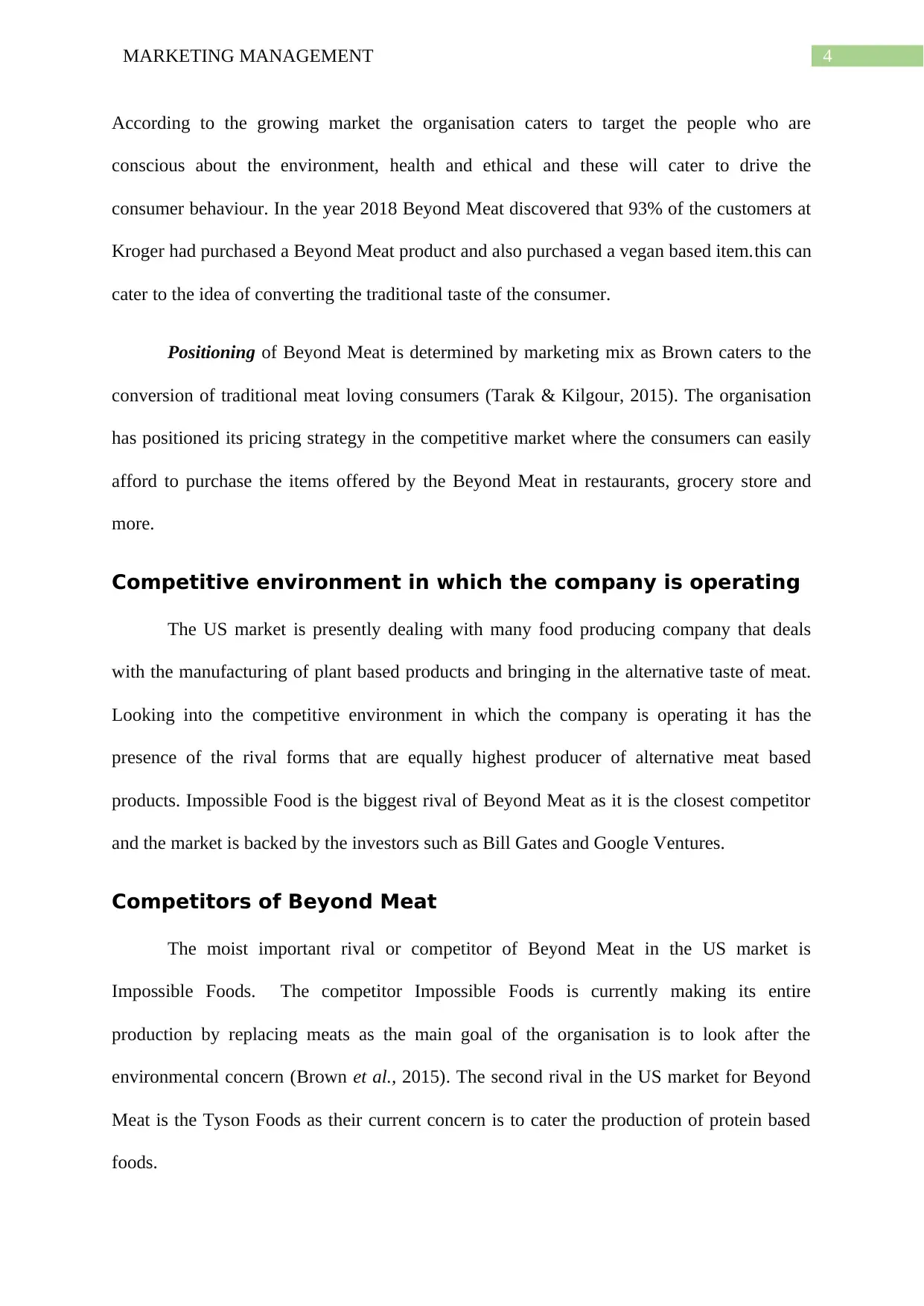
4MARKETING MANAGEMENT
According to the growing market the organisation caters to target the people who are
conscious about the environment, health and ethical and these will cater to drive the
consumer behaviour. In the year 2018 Beyond Meat discovered that 93% of the customers at
Kroger had purchased a Beyond Meat product and also purchased a vegan based item.this can
cater to the idea of converting the traditional taste of the consumer.
Positioning of Beyond Meat is determined by marketing mix as Brown caters to the
conversion of traditional meat loving consumers (Tarak & Kilgour, 2015). The organisation
has positioned its pricing strategy in the competitive market where the consumers can easily
afford to purchase the items offered by the Beyond Meat in restaurants, grocery store and
more.
Competitive environment in which the company is operating
The US market is presently dealing with many food producing company that deals
with the manufacturing of plant based products and bringing in the alternative taste of meat.
Looking into the competitive environment in which the company is operating it has the
presence of the rival forms that are equally highest producer of alternative meat based
products. Impossible Food is the biggest rival of Beyond Meat as it is the closest competitor
and the market is backed by the investors such as Bill Gates and Google Ventures.
Competitors of Beyond Meat
The moist important rival or competitor of Beyond Meat in the US market is
Impossible Foods. The competitor Impossible Foods is currently making its entire
production by replacing meats as the main goal of the organisation is to look after the
environmental concern (Brown et al., 2015). The second rival in the US market for Beyond
Meat is the Tyson Foods as their current concern is to cater the production of protein based
foods.
According to the growing market the organisation caters to target the people who are
conscious about the environment, health and ethical and these will cater to drive the
consumer behaviour. In the year 2018 Beyond Meat discovered that 93% of the customers at
Kroger had purchased a Beyond Meat product and also purchased a vegan based item.this can
cater to the idea of converting the traditional taste of the consumer.
Positioning of Beyond Meat is determined by marketing mix as Brown caters to the
conversion of traditional meat loving consumers (Tarak & Kilgour, 2015). The organisation
has positioned its pricing strategy in the competitive market where the consumers can easily
afford to purchase the items offered by the Beyond Meat in restaurants, grocery store and
more.
Competitive environment in which the company is operating
The US market is presently dealing with many food producing company that deals
with the manufacturing of plant based products and bringing in the alternative taste of meat.
Looking into the competitive environment in which the company is operating it has the
presence of the rival forms that are equally highest producer of alternative meat based
products. Impossible Food is the biggest rival of Beyond Meat as it is the closest competitor
and the market is backed by the investors such as Bill Gates and Google Ventures.
Competitors of Beyond Meat
The moist important rival or competitor of Beyond Meat in the US market is
Impossible Foods. The competitor Impossible Foods is currently making its entire
production by replacing meats as the main goal of the organisation is to look after the
environmental concern (Brown et al., 2015). The second rival in the US market for Beyond
Meat is the Tyson Foods as their current concern is to cater the production of protein based
foods.
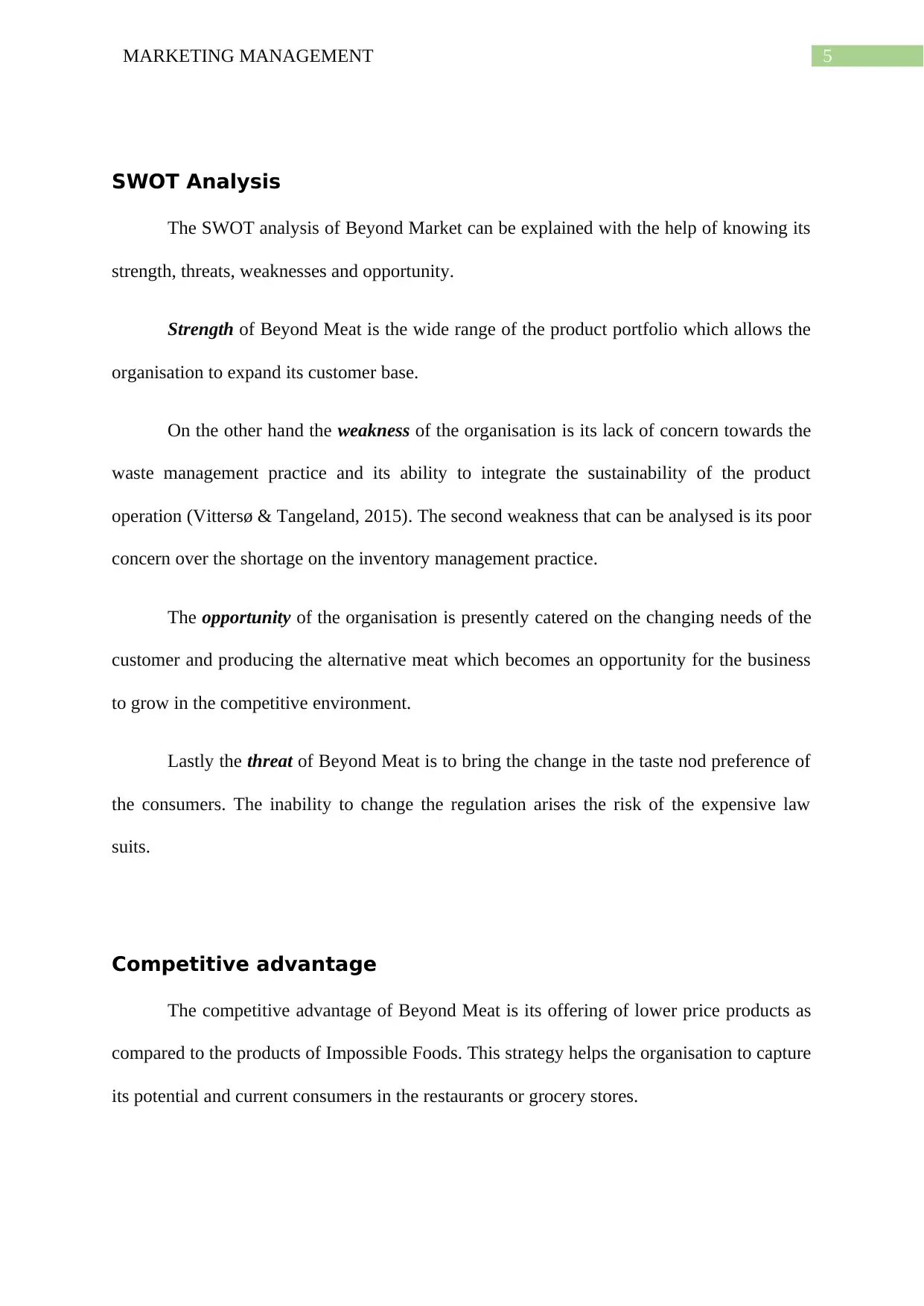
5MARKETING MANAGEMENT
SWOT Analysis
The SWOT analysis of Beyond Market can be explained with the help of knowing its
strength, threats, weaknesses and opportunity.
Strength of Beyond Meat is the wide range of the product portfolio which allows the
organisation to expand its customer base.
On the other hand the weakness of the organisation is its lack of concern towards the
waste management practice and its ability to integrate the sustainability of the product
operation (Vittersø & Tangeland, 2015). The second weakness that can be analysed is its poor
concern over the shortage on the inventory management practice.
The opportunity of the organisation is presently catered on the changing needs of the
customer and producing the alternative meat which becomes an opportunity for the business
to grow in the competitive environment.
Lastly the threat of Beyond Meat is to bring the change in the taste nod preference of
the consumers. The inability to change the regulation arises the risk of the expensive law
suits.
Competitive advantage
The competitive advantage of Beyond Meat is its offering of lower price products as
compared to the products of Impossible Foods. This strategy helps the organisation to capture
its potential and current consumers in the restaurants or grocery stores.
SWOT Analysis
The SWOT analysis of Beyond Market can be explained with the help of knowing its
strength, threats, weaknesses and opportunity.
Strength of Beyond Meat is the wide range of the product portfolio which allows the
organisation to expand its customer base.
On the other hand the weakness of the organisation is its lack of concern towards the
waste management practice and its ability to integrate the sustainability of the product
operation (Vittersø & Tangeland, 2015). The second weakness that can be analysed is its poor
concern over the shortage on the inventory management practice.
The opportunity of the organisation is presently catered on the changing needs of the
customer and producing the alternative meat which becomes an opportunity for the business
to grow in the competitive environment.
Lastly the threat of Beyond Meat is to bring the change in the taste nod preference of
the consumers. The inability to change the regulation arises the risk of the expensive law
suits.
Competitive advantage
The competitive advantage of Beyond Meat is its offering of lower price products as
compared to the products of Impossible Foods. This strategy helps the organisation to capture
its potential and current consumers in the restaurants or grocery stores.
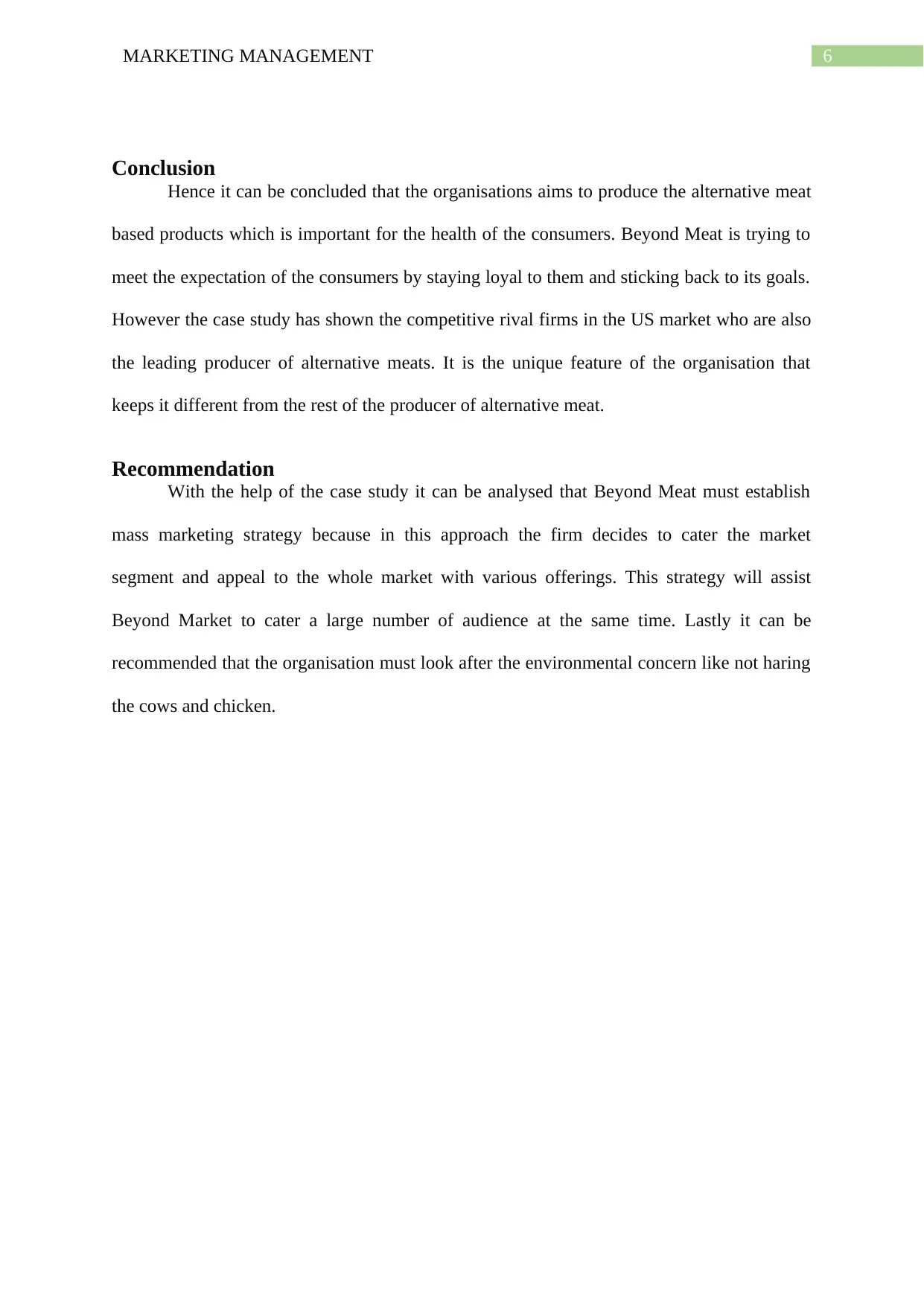
6MARKETING MANAGEMENT
Conclusion
Hence it can be concluded that the organisations aims to produce the alternative meat
based products which is important for the health of the consumers. Beyond Meat is trying to
meet the expectation of the consumers by staying loyal to them and sticking back to its goals.
However the case study has shown the competitive rival firms in the US market who are also
the leading producer of alternative meats. It is the unique feature of the organisation that
keeps it different from the rest of the producer of alternative meat.
Recommendation
With the help of the case study it can be analysed that Beyond Meat must establish
mass marketing strategy because in this approach the firm decides to cater the market
segment and appeal to the whole market with various offerings. This strategy will assist
Beyond Market to cater a large number of audience at the same time. Lastly it can be
recommended that the organisation must look after the environmental concern like not haring
the cows and chicken.
Conclusion
Hence it can be concluded that the organisations aims to produce the alternative meat
based products which is important for the health of the consumers. Beyond Meat is trying to
meet the expectation of the consumers by staying loyal to them and sticking back to its goals.
However the case study has shown the competitive rival firms in the US market who are also
the leading producer of alternative meats. It is the unique feature of the organisation that
keeps it different from the rest of the producer of alternative meat.
Recommendation
With the help of the case study it can be analysed that Beyond Meat must establish
mass marketing strategy because in this approach the firm decides to cater the market
segment and appeal to the whole market with various offerings. This strategy will assist
Beyond Market to cater a large number of audience at the same time. Lastly it can be
recommended that the organisation must look after the environmental concern like not haring
the cows and chicken.
Paraphrase This Document
Need a fresh take? Get an instant paraphrase of this document with our AI Paraphraser
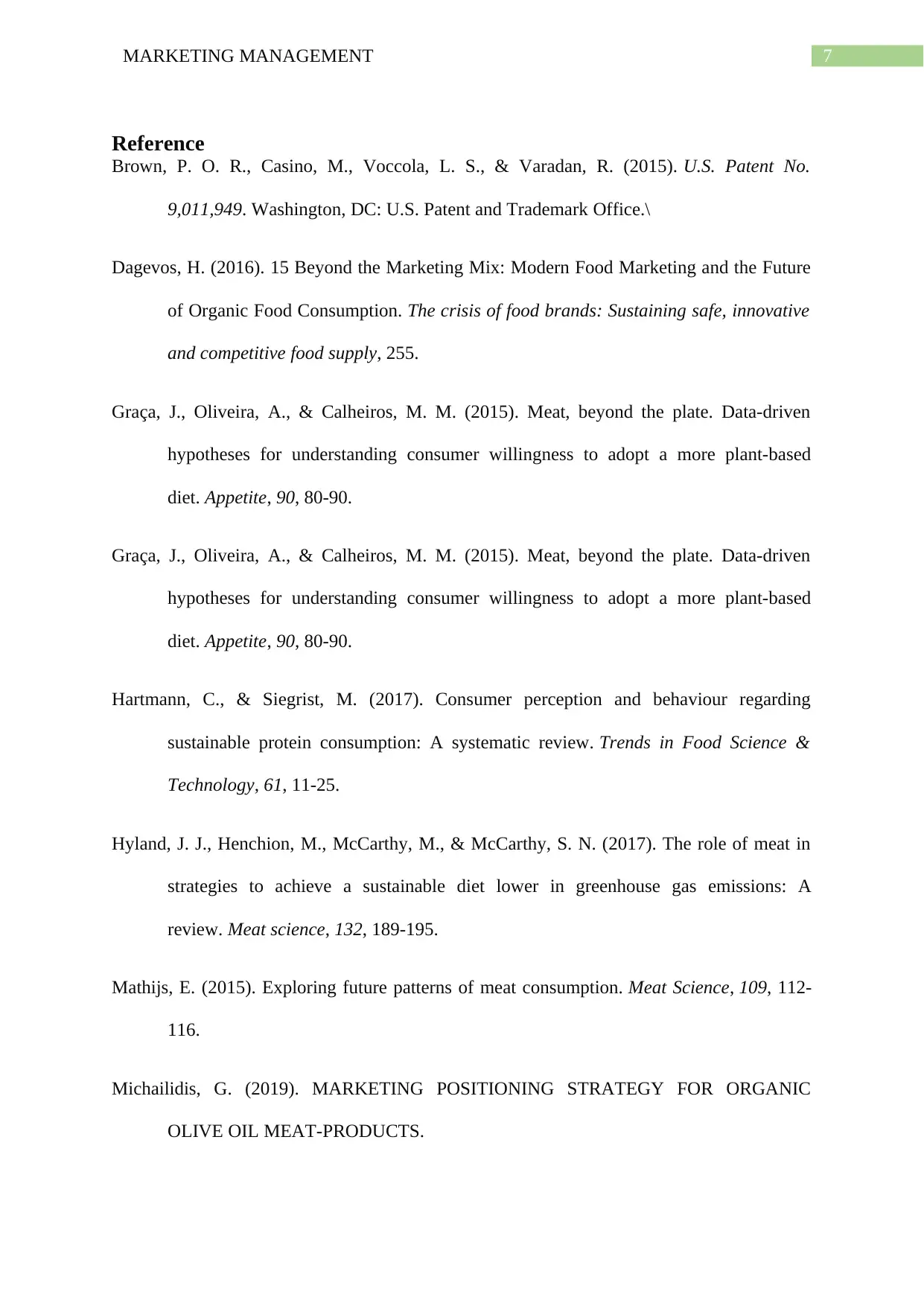
7MARKETING MANAGEMENT
Reference
Brown, P. O. R., Casino, M., Voccola, L. S., & Varadan, R. (2015). U.S. Patent No.
9,011,949. Washington, DC: U.S. Patent and Trademark Office.\
Dagevos, H. (2016). 15 Beyond the Marketing Mix: Modern Food Marketing and the Future
of Organic Food Consumption. The crisis of food brands: Sustaining safe, innovative
and competitive food supply, 255.
Graça, J., Oliveira, A., & Calheiros, M. M. (2015). Meat, beyond the plate. Data-driven
hypotheses for understanding consumer willingness to adopt a more plant-based
diet. Appetite, 90, 80-90.
Graça, J., Oliveira, A., & Calheiros, M. M. (2015). Meat, beyond the plate. Data-driven
hypotheses for understanding consumer willingness to adopt a more plant-based
diet. Appetite, 90, 80-90.
Hartmann, C., & Siegrist, M. (2017). Consumer perception and behaviour regarding
sustainable protein consumption: A systematic review. Trends in Food Science &
Technology, 61, 11-25.
Hyland, J. J., Henchion, M., McCarthy, M., & McCarthy, S. N. (2017). The role of meat in
strategies to achieve a sustainable diet lower in greenhouse gas emissions: A
review. Meat science, 132, 189-195.
Mathijs, E. (2015). Exploring future patterns of meat consumption. Meat Science, 109, 112-
116.
Michailidis, G. (2019). MARKETING POSITIONING STRATEGY FOR ORGANIC
OLIVE OIL MEAT-PRODUCTS.
Reference
Brown, P. O. R., Casino, M., Voccola, L. S., & Varadan, R. (2015). U.S. Patent No.
9,011,949. Washington, DC: U.S. Patent and Trademark Office.\
Dagevos, H. (2016). 15 Beyond the Marketing Mix: Modern Food Marketing and the Future
of Organic Food Consumption. The crisis of food brands: Sustaining safe, innovative
and competitive food supply, 255.
Graça, J., Oliveira, A., & Calheiros, M. M. (2015). Meat, beyond the plate. Data-driven
hypotheses for understanding consumer willingness to adopt a more plant-based
diet. Appetite, 90, 80-90.
Graça, J., Oliveira, A., & Calheiros, M. M. (2015). Meat, beyond the plate. Data-driven
hypotheses for understanding consumer willingness to adopt a more plant-based
diet. Appetite, 90, 80-90.
Hartmann, C., & Siegrist, M. (2017). Consumer perception and behaviour regarding
sustainable protein consumption: A systematic review. Trends in Food Science &
Technology, 61, 11-25.
Hyland, J. J., Henchion, M., McCarthy, M., & McCarthy, S. N. (2017). The role of meat in
strategies to achieve a sustainable diet lower in greenhouse gas emissions: A
review. Meat science, 132, 189-195.
Mathijs, E. (2015). Exploring future patterns of meat consumption. Meat Science, 109, 112-
116.
Michailidis, G. (2019). MARKETING POSITIONING STRATEGY FOR ORGANIC
OLIVE OIL MEAT-PRODUCTS.
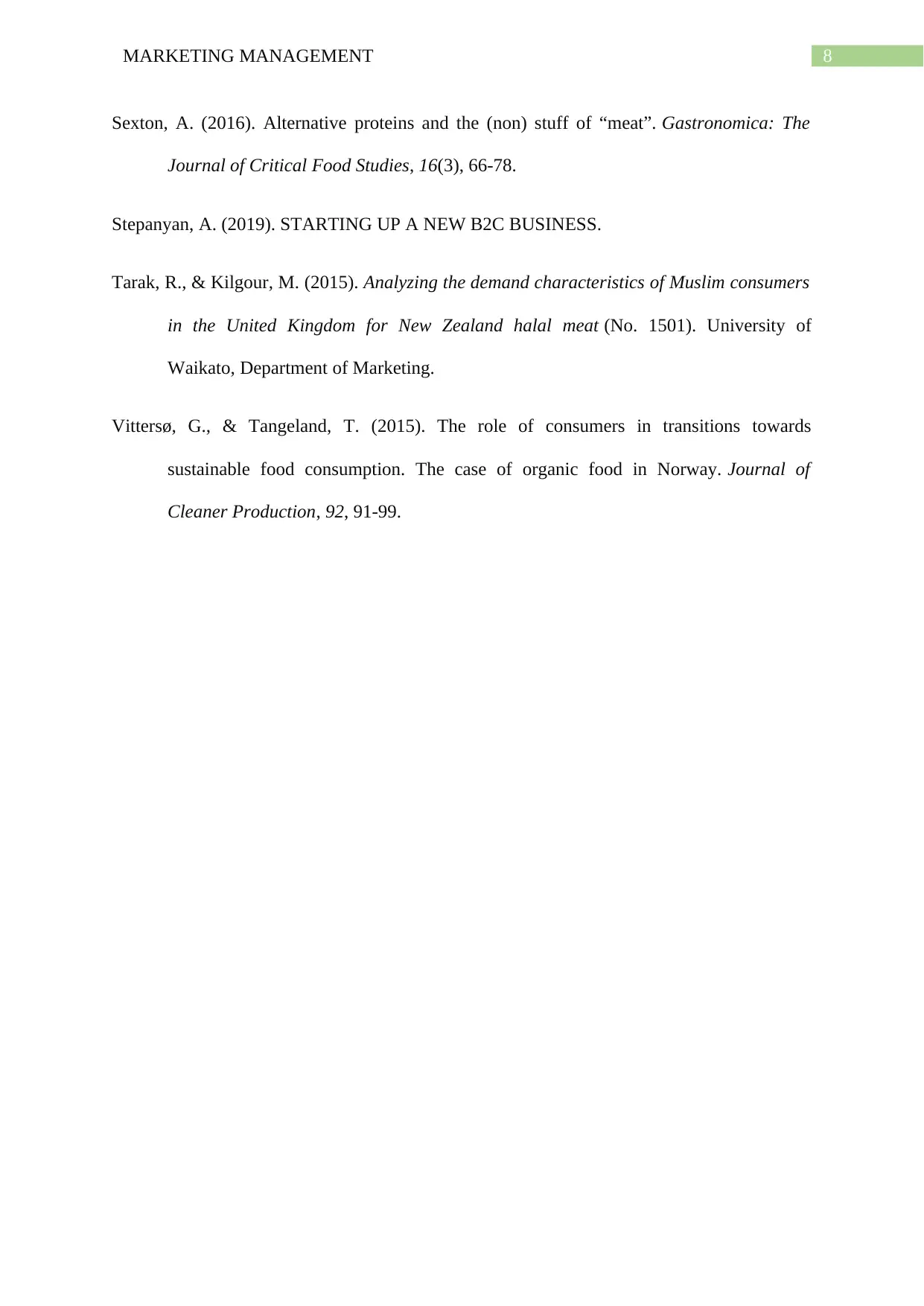
8MARKETING MANAGEMENT
Sexton, A. (2016). Alternative proteins and the (non) stuff of “meat”. Gastronomica: The
Journal of Critical Food Studies, 16(3), 66-78.
Stepanyan, A. (2019). STARTING UP A NEW B2C BUSINESS.
Tarak, R., & Kilgour, M. (2015). Analyzing the demand characteristics of Muslim consumers
in the United Kingdom for New Zealand halal meat (No. 1501). University of
Waikato, Department of Marketing.
Vittersø, G., & Tangeland, T. (2015). The role of consumers in transitions towards
sustainable food consumption. The case of organic food in Norway. Journal of
Cleaner Production, 92, 91-99.
Sexton, A. (2016). Alternative proteins and the (non) stuff of “meat”. Gastronomica: The
Journal of Critical Food Studies, 16(3), 66-78.
Stepanyan, A. (2019). STARTING UP A NEW B2C BUSINESS.
Tarak, R., & Kilgour, M. (2015). Analyzing the demand characteristics of Muslim consumers
in the United Kingdom for New Zealand halal meat (No. 1501). University of
Waikato, Department of Marketing.
Vittersø, G., & Tangeland, T. (2015). The role of consumers in transitions towards
sustainable food consumption. The case of organic food in Norway. Journal of
Cleaner Production, 92, 91-99.
1 out of 9
Related Documents
Your All-in-One AI-Powered Toolkit for Academic Success.
+13062052269
info@desklib.com
Available 24*7 on WhatsApp / Email
![[object Object]](/_next/static/media/star-bottom.7253800d.svg)
Unlock your academic potential
© 2024 | Zucol Services PVT LTD | All rights reserved.





